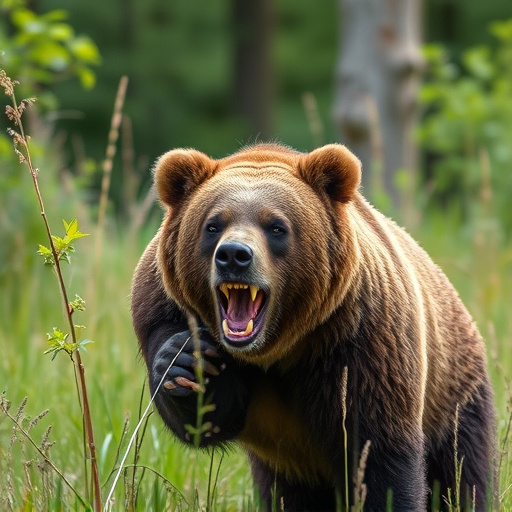Bear spray, a key defense tool in bear-inhabited areas, deters and repels bears through capsaicin and other chemicals. Its usage is governed by state laws, with requirements varying across the US; mandatory in some states like California and Washington, while recommended elsewhere. Hikers must understand and comply with local regulations, ensuring they have approved bear spray cans and use them correctly (from 20-30 feet away, aiming for face and eyes) upon bear encounter, only as a last resort. Regular training is vital to guarantee its effectiveness.
“Explore the great outdoors with peace of mind – understanding the importance of bear repellent spray is a vital step for any hiker. This comprehensive guide navigates the world of bear spray, delving into its effectiveness, legal considerations across states, and practical usage tips.
From ‘Understanding Bear Spray: What It Is and How It Works’ to ‘Bear Spray Legal Requirements by State’ and ‘Safety Tips’, this article ensures you’re equipped with the knowledge needed for a safe and enjoyable hike in bear country.”
- Understanding Bear Spray: What It Is and How It Works
- Bear Spray Legalities: State-by-State Regulations
- When and How to Use Bear Spray During Hiking
- Safety Tips and Best Practices for Bear Repellent Spray
Understanding Bear Spray: What It Is and How It Works
Bear spray, also known as bear repellent, is a crucial tool for hikers and outdoor enthusiasts navigating areas with bear populations. It’s more than just a spray; it’s a defense mechanism designed to deter bears from approaching humans. When used correctly, bear spray creates an immediate barrier, temporarily blinding and disorienting the animal, allowing you time to retreat safely. This isn’t about killing or harming bears but about coexisting peacefully in their environment.
Understanding how bear spray works is essential, especially considering the varying legal requirements by state regarding its possession and use. In many regions, carrying bear spray is mandatory for hiking in certain areas designated as high-risk for bear encounters. The effectiveness of bear spray depends on factors like the distance between you and the bear, wind conditions, and the bear’s behavior. Bear spray is typically a combination of capsaicin, an ingredient found in chili peppers, and other chemicals that cause irritation to a bear’s eyes and respiratory system. This irritation prompts the bear to retreat, providing a critical window for safe escape.
Bear Spray Legalities: State-by-State Regulations
Bear spray, a powerful deterrent against aggressive bears, is a crucial addition to any hiker’s emergency kit. However, its legality varies from state to state in the US. Before venturing into bear country, understanding these regulations is essential for your safety and compliance with local laws. Some states require hikers and outdoor enthusiasts to carry bear spray as a mandatory precaution, while others have more flexible guidelines.
For instance, states like California, Washington, and Oregon have strict rules mandating the use and carrying of bear spray in certain areas known for high bear activity. In contrast, states such as Texas and Florida do not have specific laws requiring bear spray but still recommend its use for added protection. It’s crucial to check with your state’s wildlife or outdoor recreation department to understand the legal requirements for carrying bear spray during your hike.
When and How to Use Bear Spray During Hiking
When hiking in areas known for bear populations, carrying and knowing how to use bear spray is essential. It’s a powerful tool for deterring bears if you encounter one on the trail. Before setting out, familiarize yourself with the legal requirements for bear spray possession and usage by state; these vary significantly. Ensure you have a can of approved bear spray, preferably one designed for hiking and made to meet specific industry standards.
At the first sign of a bear or its tracks, stop and assess the situation. If the bear hasn’t noticed you yet, make noise by talking loudly or clapping your hands to alert it to your presence. Face the bear head-on, backing away slowly while spraying the bear with bear spray from 20-30 feet away. Aim for the bear’s face and eyes if possible. If the bear charges, continue spraying until you’ve used all the contents of the can or the bear stops attacking.
Safety Tips and Best Practices for Bear Repellent Spray
When carrying bear repellent spray, understanding local legal requirements is crucial. The regulations regarding bear spray vary significantly by state, with some states mandating its use in specific areas known for bear populations and others allowing it only for certain outdoor activities. Before heading into the wilderness, always check the Bear Spray Legal Requirements by State to ensure compliance.
Best practices dictate that you should never approach a bear, but rather, maintain a safe distance and use bear spray as a last resort. Proper usage involves holding the can upright, aiming slightly below the bear’s nose level, and spraying in a sweeping motion. Keep the nozzle focused on the bear until the canister is empty or the bear shows signs of retreat. Remember, practice makes perfect; familiarize yourself with the spray’s functionality through regular training to ensure its effectiveness during an encounter.
In conclusion, bear repellent spray is an essential tool for hikers navigating areas with bear populations. Understanding its effectiveness, familiarizing yourself with state-specific legal requirements (Bear Spray Legal Requirements by State), and learning the proper usage techniques can significantly enhance safety during outdoor adventures. Always follow safety tips and best practices to ensure a positive and secure hiking experience in bear country.
